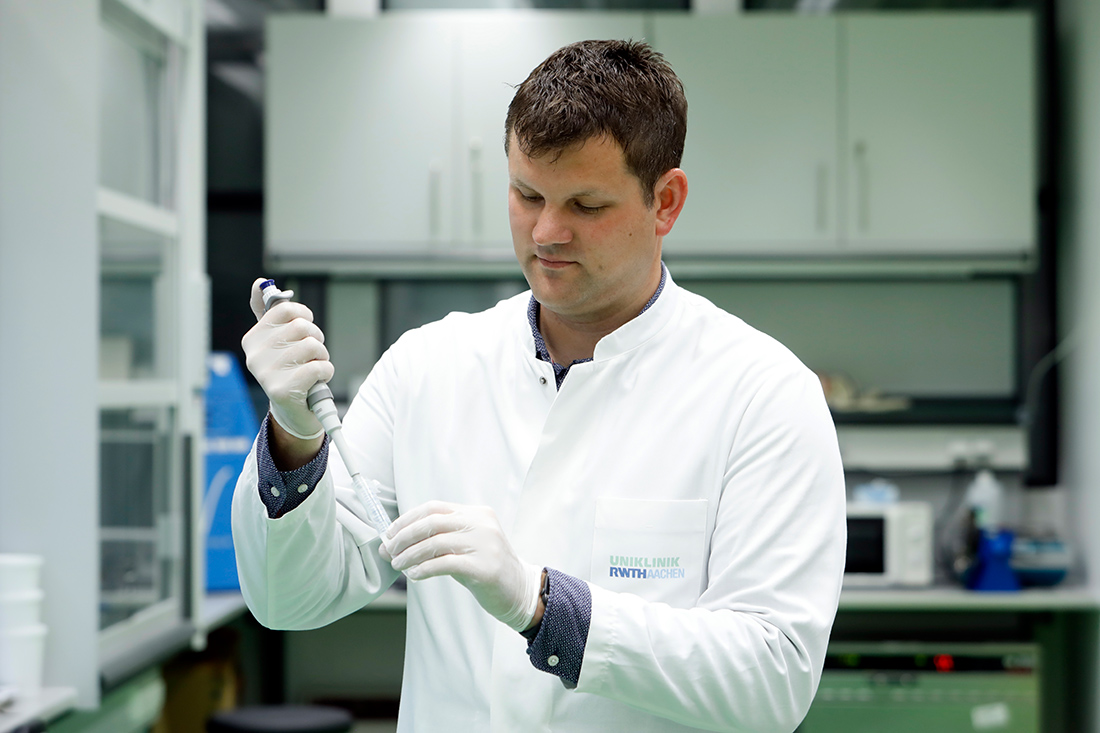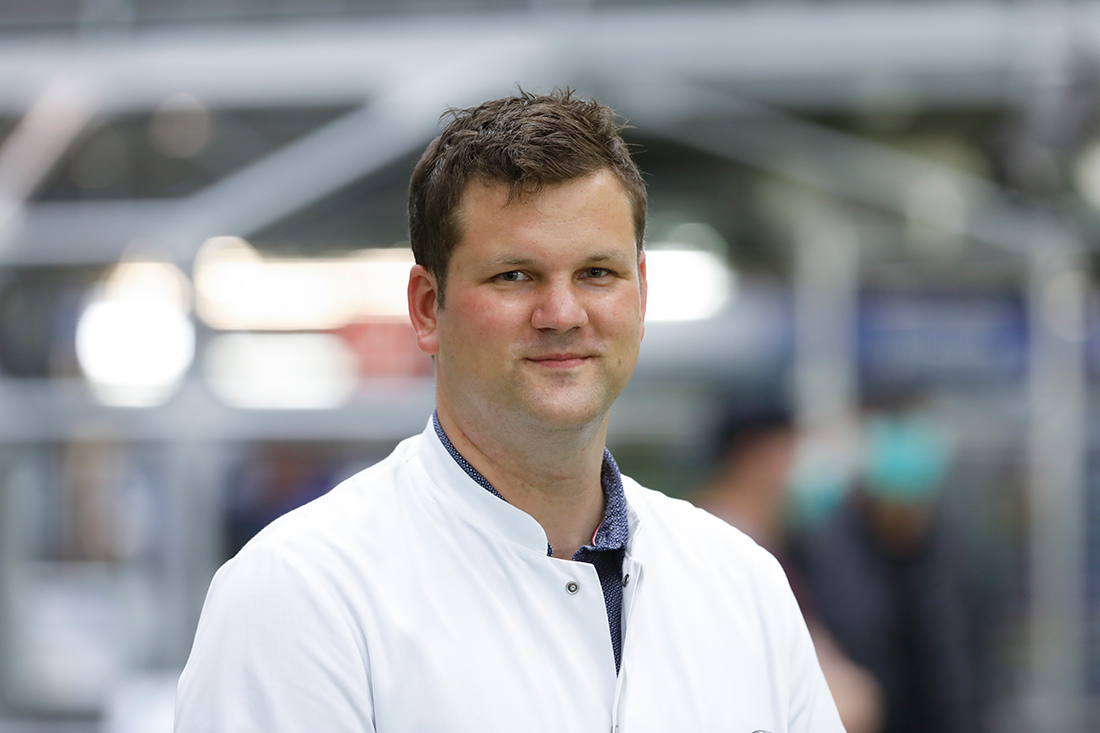)
We drew a map of the heart, so to speak.German version/Deutsche Version
A reliable filter
Another aspect of the kidney that Kuppe admires is the fact that the kidney filter manages never to clog, unlike the oil filter in a car, for example. “Our blood has a high protein concentration, but the primary urine filtered by our kidneys does not contain any protein at all. It is completely protein-free.” But we do not fully understand how that is possible. The kidney filter’s capacity to stay unclogged cannot entirely be explained by the mere fact that kidney cells are able to take up and break down those proteins entering the filter, Kuppe adds. “There must be other mechanisms.” He thinks the glomeruli could enable signaling interactions between the endothelial cells of the renal capillaries and special cells within the renal epithelium, the podocytes, that take care of cleaning the filter. In addition, the filter had an electric charge. Apparently, there were interactions at the intersection between physics and biology that keep the filter free. “We have published a model of how we think this works, but the question has not yet been conclusively resolved.”
Between bench and bedside
Said model was published years after Koppe was licensed for medical practice. And during these years of practical experience, Christoph Kuppe had already lead-authored almost enough academic publications to submit them to RWTH Aachen University for postdoctoral graduation. This earned him the Venia Legendi as a private lecturer for internal medicine and nephrology in 2021. Ten years prior, he had received his doctorate from RWTH Aachen. Already back then, in his doctoral thesis, had he successfully dealt with kidneys. During the years following graduation, he was able to broaden his knowledge through fruitful stints like research collaborations with nephropathologist Prof. Hermann-Josef Gröne at the German Cancer Research Center (DKFZ) in Heidelberg. “Getting to know the work of such a renowned research institute really motivated me.” However, Kuppe never wanted to limit himself exclusively to research. Instead, he has always been working clinically, attending patients at bedside. Even today, while setting up his own lab as part of the Emmy Noether programme, equipped with an ERC Starting Grant and temporarily focusing entirely on research, he is already aiming for a 50:50 split between research and clinical care in 2023.
Extraordinary nephrological research
One of the most common conditions in renal medicine is chronic kidney disease (CKD), in which the kidney’s filtration rate drops below half its normal value. The problem affects more than ten percent of the world’s population. In industrialized countries, more than 30 percent of all CKD cases can be traced back to diabetes. The main characteristic of this disease is that it leads to an increasing scarring of the kidney. Once this fibrosis has begun, its progression is almost impossible to halt. Current treatment options are inadequate. Almost inevitably, CKD leads to cardiovascular or renal failure. Christoph Kuppe’s major goal is to change this. Just recently, he has made an extraordinary step in that direction: He was able to prove that the fibrosis originates in a certain type of cells in the renal cortex[i]. Although it was known before that scar formation is mainly caused by so-called “myofibroblasts”, science did not know their exact origin. Part of that difficult quest was the kidney’s high cellular heterogeneity, with as much as 26 different cell types. Kuppe and his team solved it with the help of a relatively new technique called “single-cell RNA sequencing”.

Mapping the activity of individual kidney cells
In this technique, complex tissues are dissected into individual cells. Then scientists use methods from the field of microfluidics to enclose each of these cells in a single drop of liquid and analyse it for its messenger RNA pattern, its “transcriptome”. This allows researchers to determine which genes are currently active in each individual cell. Using this method, Kuppe could profile about 100,000 cells from healthy and unhealthy human kidneys, and map their respective locations in the kidney tissue. He was particularly interested in the production of collagen and other proteins that form the extracellular matrix (ECM) and promote scarring. He also investigated the production of molecules involved in growth-promoting signaling pathways. This is what he found: Renal fibrosis starts with cells called “fibroblasts” and “pericytes”. Fibroblasts are important supporting elements of the organ structure. Pericytes stabilise the smallest blood capillaries. Kuppe and his team believe that a dysfunction in the renal tubule activates both cell types and makes them transform into myofibroblasts, which then remodel the tissue fibrotically. One growth signal that plays a role in this remodeling process is the protein NKD2. So far, it is known as a dampening regulator of the Wnt signaling pathway, which ensures a healthy balance in tissues whose cells divide and grow, and therefore should not be overstimulated. Kuppe’s findings suggest that NKD2 may have an opposite function in chronic kidney disease, which could make it a target for new drug therapies. “But we are still far from developing a drug specifically designed to stop fibrosis in the kidney.” Kuppe adds that, currently, SGLT-2 inhibitors are the most potent agents in slowing down the progression of chronic kidney disease, although they had originally been developed to treat diabetes. “We don’t yet understand why they are so protective,” Kuppe says. This is one of the questions he plans to explore in his “Decode DKD” project.
Beyond generic standard treatments
DKD is short for diabetic kidney disease and accounts for that third of all cases of kidney insufficiency that are caused by diabetes. While there seems to be a strong genetic influence in this – Kuppe says: “We know of families suffering from diabetes in which nephropathies develop particularly frequently” – it still remains unclear which type of diabetic trigger causes all the other cases, and how individual pathways to DKD differ from each other. “And we need to understand that, in order to treat each patient as effectively as possible,” Kuppe concludes. Until now, DKD patients have mostly been treated with the same standard therapy as all other kidney patients: They are given ACE inhibitors to control blood pressure and a certain amount of immunosuppressants, complemented by a low-salt and healthy diet. “This is not satisfactory. My vision is to decode the heterogeneity of all these patients, down to the molecular level, so we can start treating them as individually as possible.”
Involving Epigenetics
Transcriptome analysis alone will not suffice to achieve this, because it only provides information about the output of a cell’s gene expression, but does not reflect the process itself. Which means that it tells us nothing about which chromatin segments are accessible for transcription and what exactly happens on them. To investigate this, you need epigenetics. In chromatin, the almost two meters of DNA thread in each cell nucleus are wound compactly onto protein beads. Only in the temporarily unraveled areas of this tangle can transcription factors attach themselves and initiate gene expression, by docking onto cis-regulatory elements. These elements determine how the expression of neighboring genes plays out. These regulatory elements, as well as the genes regulated by them, can be identified using a technique called “ATAC-Seq”. Combined with a suitable bioinformatics protocol, this technique can be applied to individual kidney cells in a way that provides significant results. Kuppe has shown that in a research collaboration with his mentor Prof. Rafael Kramann and Aachen-based bioinformatician Prof. Ivan G. Costa. During this process, they discovered Runx 1, a transcription factor that plays a significant role in the development of renal fibrosis.[ii]
Uncharted cardiological territory
Kuppe has gained a lot of expertise observing and analysing the activities of individual kidney cells at the levels of the epigenome, the transcriptome and the proteome. He can also apply that expertise to research on other organs. For example, he and his colleagues in Aachen have used the multi-level single-cell omics method, which they established in cooperation with a research group at Heidelberg University Hospital, to study the cellular processes involved in remodeling the heart muscle after myocardial infarction. This analysis can be differentiated according to the different cell types and their respective distance from the center of the ischemic event. To translate the overwhelming amount of data into significant information, the team recurred to artificial intelligence. “We drew a map of the heart, so to speak, on which we could retrace the consequences of a heart attack.” With this map, scientists around the world can now enter previously uncharted territory – because until now, the cellular processes involved in post-infarction cardiovascular remodeling were largely unknown. But knowledge of these processes is necessary to better prevent fatal long-term effects of a survived heart attack. Which is why Kuppe and his colleagues have decided to use an open source license to make their post-infarction map freely available to the entire scientific community.[iii]

Author: Joachim Pietzsch, Wissenswort
Photos: © Uwe Dettmar
[i] Kuppe, C.*, Ibrahim, M.M.*, Kranz, J., Zhang, X., Ziegler, S., Perales-Paton, J., Jansen, J., Reimer, K.C., Smith, J.R., Dobie, R., et al. (2021). Decoding myofibroblast origins in human kidney fibrosis. Nature 589, 281-286. 10.1038/s41586-020-2941-1.
[ii] Li, Z.*, Kuppe, C.*, Ziegler, S., Cheng, M., Kabgani, N., Menzel, S., Zenke, M., Kramann, R., and Costa, I.G. (2021). Chromatin-accessibility estimation from single- cell ATAC-seq data with scOpen. Nat Commun. 12, 6386. 10.1038/s41467-021- 26530-2.
[iii] Kuppe, C.*, Ramirez Flores, R.*, Li, Z.*, Hayat, S., Levinson, R., Liao, X., Hannani, M., Tanevscki, J., Wünnemann, F., Nagai, J., et al. (2022). Spatial multi-omic map of human myocardial infarction. Nature. 10.1038/s41586-022-05060-x